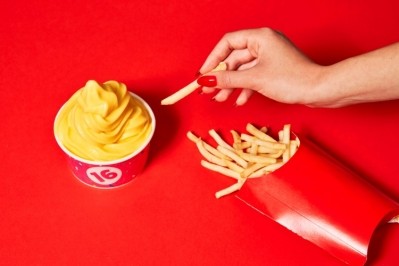Weight loss drugs may be melting US ice cream demand

According to 2023 USDA ERS data, Americans have consumed around 4 pounds less regular-fat ice cream from 2000 to 2021, with other frozen dairy products such as yogurt and sherbet declining from 3.4 pounds per person in year 2000 to 1.9 pounds in 2021.
Shifting consumer preferences are partly behind the downward trend, with Americans reducing their intake of caloric sweeteners from 150.9 pounds to 127.4 pounds per capita in 2021 compared to 2000. Other factors include smaller tub sizes and greater competition between brands.
Appetite for low-fat and nonfat ice cream has been roughly the same throughout the period however, at 6.6 pounds per person in 2000 and 2021.
In 2024, the consumer price index (CPI) for ice cream declined in the first three months of the year but rose sharply in April and declined only marginally in May, remaining elevated year on year. Experts predict ice cream prices to remain high this year, which may affect consumer spending in the category.
Other factors, such as US consumers’ growing interest in weight loss drugs, is also likely to influence demand dynamics in ice cream. In 2023, weight-loss drugs were the main driver of a 13.5% increase in spending on prescription medications in the US according to the American Society of Health-System Pharmacists (ASHSP).
Products like Ozempic and Wegovy are GLP-1 drugs, named after the hormone they mimic and which is activated by food intake. The drugs can suppress appetite and help the body produce more insulin, which is why they have been traditionally used for managing diabetes.
ASHSP predicted overall prescription drug spending to rise by 10%-12% in 2024 as spending on weight-loss drugs continues to climb and supplies catch up with demand.
How will US ice cream prices move in 2024?
Americans have seen ice cream prices rise to record heights in 2022 and 2023. Speaking during Rabobank’s annual BBQ Index presentation, dairy analyst Lucas Fuess said that 2024 is unlikely to provide relief in terms of ice cream pricing.
This is largely due to cream prices, with ice cream competing with butter for this core input.
“If cream is not frozen into ice cream, we are putting it into the churn and making butter out of it,” Fuess explained. “And so far, we have seen very firm butter demand over not only the past several months but the past few years.”
“[This means that] when butter is pulling a lot of cream throughout the supply chain, that leaves a little bit less for ice cream. And of course, is supportive to the ice cream price overall.”
This suggests that ice cream prices for Americans at the grocery store are unlikely to come down any time soon. In fact, prices this year may prove to be higher than in 2023 if the same market dynamics remain in place.
Small portions may unlock stalling consumer demand
Fuess closed off his presentation with the prediction that the overarching trend of falling ice cream consumption ‘will persist’. “Largely, what’s driving this is not only smaller carton sizes…, it’s very difficult to find that traditional half-gallon tub of ice cream in the frozen section at the grocery store,” he said.
“General increase in competitiveness among frozen desserts, whether that’s trading down to much cheaper popsicles that have no dairy or novelty desserts like mochi ice cream or even smoothies that have limited dairy, this increased competition has reduced overall ice cream consumption, a pattern that I do think will persist.
“And ultimately, when we think about weight loss drugs and the surging use of [GLP-1 medications such as] Ozempic and Wegovy, ice cream not a winner there when we think about how that changes American consumption habits.”
Innovation around smaller portions, such as mini ice creams, bites and mini tubs, may entice those shoppers who want to indulge while also hoping to maintain a healthy lifestyle.
According to Mintel, nearly two thirds (62%) of US consumers prefer a smaller but indulgent ice cream rather than a low-calorie version, with opportunities for manufacturers to explore ice cream as a snack that’s a permissible indulgence.
Incorporating health claims and premium ingredients can also help brands differentiate while also elevating flavor experiences.










